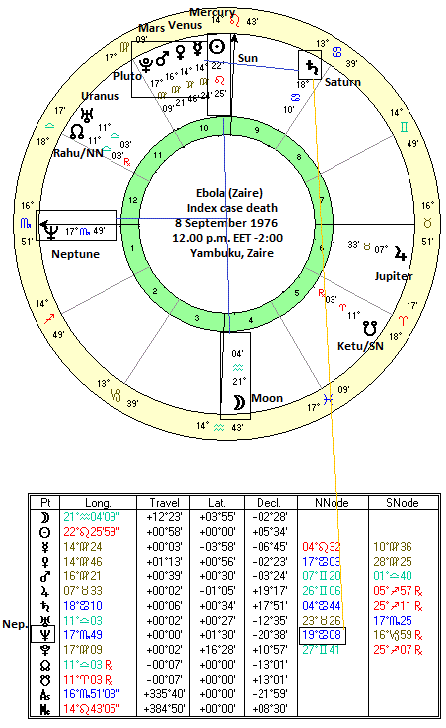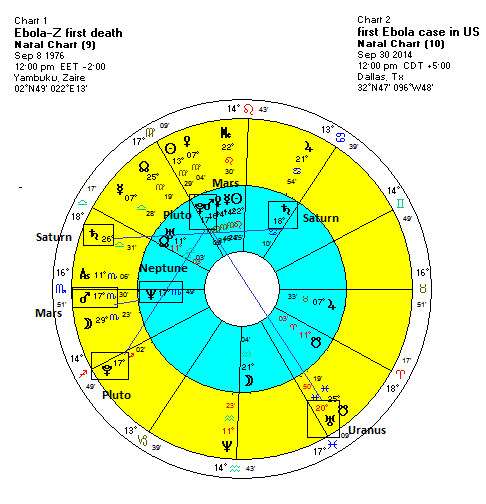 (5 October 2014)
The deadly Ebola epidemic entered a new phase last week as the first
case was recorded in United States. On September 30th, the CDC
confirmed that Thomas Duncan had contracted Ebola in his native Liberia
and had become ill after arriving on a visit to his family in Dallas,
Texas. While Duncan is undergoing treatment, the CDC is scrambling to
find all his contacts between September 24 and 28 when he was
symptomatic but not yet quarantined in hospital. This is the first
recorded case outside of West Africa since the latest outbreak began in
March in Guinea. This Ebola outbreak is not yet under control and has
killed more than 3000 people to date.
(5 October 2014)
The deadly Ebola epidemic entered a new phase last week as the first
case was recorded in United States. On September 30th, the CDC
confirmed that Thomas Duncan had contracted Ebola in his native Liberia
and had become ill after arriving on a visit to his family in Dallas,
Texas. While Duncan is undergoing treatment, the CDC is scrambling to
find all his contacts between September 24 and 28 when he was
symptomatic but not yet quarantined in hospital. This is the first
recorded case outside of West Africa since the latest outbreak began in
March in Guinea. This Ebola outbreak is not yet under control and has
killed more than 3000 people to date.In a previous post in August, I offered an admittedly preliminary and somewhat speculative analysis of the current outbreak. The problem was that the beginning or "birth" of Ebola is ultimately unknowable: we cannot know exactly when it first jumped from animals to human. In the absence of any reliable data, I suggested a possible chart for the first case of Ebola in terms of an individual seeking medical attention. Based on this chart, I thought that the outbreak might begin to ebb by now. Obviously, this hasn't happened as the number of cases continues to grow exponentially.
One thing I may have got wrong was focusing on the first recorded case of Ebola in Sudan in June 1976. What is important here is to recognize that there are several different strains of Ebola. The current outbreak, which is by far the worst, is the strain that originated in Zaire -- now known as Congo. The Zaire strain of Ebola (sometimes written as Ebola-Z) began in late August 1976, fully two months after the Sudan outbreak. The Zaire outbreak was more lethal and has been implicated in most of the major serious outbreaks since. This may mean that a horoscope of the Ebola virus should focus on the Zaire strain rather than the Sudan strain.
The other factor is finding an appropriate beginning to the virus. My previous post looked at the date that the first victim sought out medical treatment. This was obviously several days after they contracted the virus so that is a rather huge margin of error. Another approach may be to examine the chart of the date of the first death from Ebola. Since the high mortality rate is one of its defining characteristics, a horoscope cast for this date could illuminate the patterns of lethality of the virus. This, in turn, could provide some insight on its possible future development.

We know that the first death from Ebola-Z occurred on September 8, 1976 in Yambuku. Mobalo Lokela sought medical treatment on August 26th and eventually died two weeks later. This became what is known as the "index case" for the Zaire strain of the Ebola virus that is currently spreading around the world.
While we don't know what time he died, the resulting horoscope nonetheless has several telling alignments of planets. When the birth time is not known, we can use the Moon as the Lagna (Ascendant) and read the chart from there. Mr. Lokela died on a Full Moon when both the Sun and Moon were in a difficult t-square pattern with Neptune. In Western astrology, Neptune is the planet of disease and sickness and it is very apt that it should be in a close tense aspect with the lights. The chart also seems appropriate that it should be associated with illness since the Lagnesh (1st house ruler) is Saturn and it is situated six houses from the Moon in Cancer. The 6th house is primarily concerned with health and the presence of lagnesh Saturn here is just what we would expect from a lethal viral disease like Ebola. Saturn is considered the most malefic planet in the horoscope and tends to do damage to whatever planets or houses it is connected with.
But the chart gets worse. Look at all those planets in Virgo in the 8th house. The 8th house represents death and chronic disease, among other things. Mercury, Venus, Mars and Pluto are all tightly clustered in the 8th house and therefore brings an additional burden to this chart. The added difficulty is that all those Virgo planets received a full-strength three house/sextile aspect from Saturn. This essentially Saturnizes all those planets and makes the 8th house that much more toxic and dangerous. The aspect is very close -- just a few degrees from the exact 60 degrees of the sextile. To be sure, Jupiter also aspects the four Virgo planets but it is a wider aspect. But Saturn is the more powerful influence by virtue of the narrower orb. Such a prominent 8th house should not be surprising for a virus that kills more than 50% of people who contract it.
We can also see that Saturn (18 Cancer) is in a very tight conjunction with the Node of Neptune (19 Cancer). Just as the Moon has Nodes (Rahu and Ketu),.so, too, do all the planets. Since Neptune is closely associated with disease, this Saturn placement on a clearly Neptunian degree is another reason why Saturn's destructive energy should have been associated with a virus in this case.

While we may better understand just how badly afflicted this chart is, we still need an explanation why the 2014 outbreak has been by far the worst in history. Without the time of the death, we can only make some general observations. In terms of transits, the once-in-eighty-year square aspect of Uranus-Pluto is hitting the tail end of that Virgo stellium. At the time of outbreak begin in March, Uranus was exactly opposite the Mars-Pluto conjunction. Uranus has only moved off a few degrees and is now backing up into another close opposition. Pluto (17 Sagittarius) is now exactly square the natal Mars-Pluto (16-17 Virgo) within a few minutes of arc. Both Uranus and Pluto are powerful activating planets when in hard aspect (0,90,180) and can release the energy contained in a natal chart in very intense and sudden ways. Although we could look at other supplementary charts, I think these transits offer a solid clue why Ebola has been much worse in 2014 compared with other years. Out of respect for Occam's razor, we should try to find an explanation that satisfies the simplest chart factors such as transits.
We can also see that Saturn has been transiting late Libra for most of the year. This forms a fairly close square aspect with its natal position and the 6th house (illness). This may be another reason why we have seen many more deaths this year.
Interestingly, the CDC's announcement of the Ebola case on September 30th has an exact conjunction of transiting Mars (17 Scorpio) with Neptune. Mars is another malefic planet that is associated with intense bursts of energy. This is perhaps appropriate given that the Ebola epidemic has seemingly entered a new global phase.
Making predictions from such a tentative and approximated chart is very hard to do. That said, I will be interested to see what happens when Mars squares up agains the Sun at 22 Scorpio in the first half of this week. This looks bad. Another window to watch is the first week of November when Mars will conjoin Pluto and therefore square all those Virgo planets. This looks like even worse news. Pluto will gradually move away from its square aspect so that could bring a lessening of severity. The trouble is that Rahu (North Node) will conjoin the Mars-Pluto conjunction in February and March. This is a particularly nasty alignment of planets so I would expect significant Ebola-related news at that time. Whether or not the virus can be brought under control by then is unclear. Without knowing the specifics, I would not be too hopeful. It seems more likely we will have to contend with Ebola well into 2015.
Financial Markets Update
All the Ebola talk provided sufficient reason for traders to sell as stocks slipped last week. Despite Friday's encouraging jobs report, US stocks lost ground with the Dow closing at 17,009. Indian stocks also wavered a bit in the holiday-shortened week as the Sensex finished at 26,567. I thought we were more likely to see declines last week given the Venus in Virgo effect. This came to pass although the precise timing left something to be desired.
This week could see a rise in volatility. In particular, the focus is on Wednesday and Thursday. A lunar eclipse occurs at 21 Pisces on Wednesday in close conjunction with unstable Uranus. Larger than normal movements is more likely around that time. Thursday's Mars-Jupiter aspect may also bring noteworthy changes in sentiment. With Venus still transiting Virgo, it is more difficult to expect gains from these patterns.